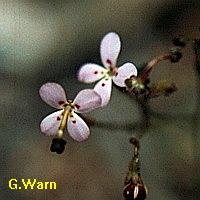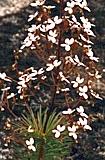|
[Front Page] [Features] [Departments] [Society Home] [Subscribe]

An Introduction to Trigger Plants
Rica Erickson
Although almost 40 years old, this article explains the mysteries of these plants which still fascinate bushwalkers today.
When I am asked, "What is a triggerplant?", I almost blurt out the answer in my haste to assure, "It's the easiest plant in the bush to recognise, because it has triggers." For from the throat of every trigger-flower rises a sensitive column or trigger that may instantly swing over when the throat of the flower is probed. It is from this column or style that their generic name of Stylidium is derived.
 
Then I tell my questioner that these flowers always have four petals. After a little more thought I explain that the four petals are usually in pairs but in some species the pairs are very unequal in size and shape. Then I feel it is necessary to mention that some triggerplants are tiny, (only a few centimetres tall) while others are bushy (one can grow to 1.8 metres tall), that several grow in wiry creeping mats and others have dense tufts of rosetted leaves. By this time my questioner's face has assumed a puzzled and hopeless look. So I quietly fall back on the statement that all triggerplants have repeatedly sensitive triggers and then we seek out a plant to demonstrate its powers.
Triggerplants flower mostly in the late spring, and in Western Australia in particular, they may be found in almost any part of the bushland.
A fine straw is plucked to stimulate the proboscis of an insect and we carefully insert the grass stem into the throat of the flower. The poised trigger is resting in a spring-like curve between the petals but when probed it swiftly and amazingly sweeps in an arc over the flower. We try another flower and yet another. Again and again the sudden reaction seizes our attention. Sometimes the triggers refuse to work. It takes a couple of minutes for each to repoise in a slow jerking movement, and after that it needs about ten minutes or so to rest in which to regain its sensitivity.
On hot days the response is very much swifter and the time required to rest is much reduced. This is neatly related to the fact that insects work much faster in warm weather.
What is the purpose of the trigger's swift movement? A magnifying lens shows that the apex of the trigger is exceedingly beautiful and often adorned with a glistening fringe. Some of the columns we view are crowned with anthers bearing four neat packets of pollen, others have the stigma looking like a hairy pincushion (See Figs.10 and 11). The anthers appear first on each trigger but as they mature and the pollen is shed they are pushed aside by the development of the stigma. This successive development of anthers and stigma prevents self pollination, while the trigger action is a neat and thrifty device to ensure cross pollination. A young flower will deposit pollen on an insect in exactly the spot where the stigma of an older flower of the same species will gather it up.
 |
Stylidium gramminifolium is the best know species. It occurs widely in eastern Australia.
Select the thumbnail image or highlighted name for a higher resolution image (47k). Photo: Geoff Warn
|
If you stand patiently near a triggerplant you may be lucky enough to see a humming bee or a bee-fly sipping at the flowers. The nectar it seeks must be very attractive, for having once sipped it the insect is impelled to visit every flower of that species within reach. It alights gently on the outstretched platform of paired petals, it sips and is immediately branded by the trigger with a perceptible blow. It receives and gives pollen throughout the proceedings unaware of the vital part it plays as the marriage agent.
The various corolla shapes found among triggerplants are related to the need for the insect to adopt the same position on the corolla at every visit. It will be struck then in the same spot on each occasion.
The most common arrangement is that of laterally paired petals. Another arrangement is of petals paired to the back and front. On these flowers, insects land on the extended front petals and the trigger swings over between the two upright petals to hit the insect's back as with the laterally paired petals. However, in a few species which have this front and back pairing, the trigger swings up from between the extended front petals and strikes the underpart of the insect's abdomen instead (see Figs.5, 6 and 7). These flowers are more than usually specific in their pollination.
The throats of many of the flowers are adorned with appendages which are best seen with the aid of a lens. Their purpose may be to direct the proboscis of the insect more accurately. Possibly the most unusual corollas are to be found in the tropical triggerplants (Fig.8) and one can only guess at the purpose of the various divisions and fusions of their petals.
There is no space in this short introduction to detail the other devices evolved by some of the plants, except possibly to mention the hinged locket trigger which folds the anthers into a protective pouch (Fig.9) and also the peculiar action of the strap-like stigma of "Book Trigger" (Figs.4, 5 and 6) a plant common to both eastern and Western Australia.

|
- "Grass Triggerplant", Stylidium graminifolium, showing habit of growth
- Flower of "Touch-me-not", S.diversifolium
- Flower of "Fan-leaved Triggerplant", S.striatum
- "Book Triggerplant", S.calcaratum, showing habit of growth
- A locket type of trigger with the anthers folded against the pouched column
- Released trigger of "Book Trigger" showing the strap stigma lying along the column
- "Topsy-turvy Triggerplant", S.spinulosum with trigger poised below the flower
- S.fissilobium, a tropical triggerplant with divided petals
- A locket type of trigger with the anthers folded against the pouched column
- Anthers at the apex of a typical trigger column
- Hairy stigma cushion developing between the empty anthers
|
No one has yet determined just what makes the trigger work, although scientists have studied the problem spasmodically ever since triggerplants were grown in the hothouses of Europe since the beginning of the last century. They have been cultivated in the Old World as botanical wonders almost ever since their discovery. So they should not be difficult to grow in the gardens of their homeland, indeed they have responded happily in those few where I have seen them. "Grass Trigger" (whose range is from near Cairns in Queensland to Tasmania and South Australia) is one of these and the "Matted Trigger" is another. The latter is a creeping plant of Western Australia and has been introduced into a garden by training the new trailing stems of bush plants to root in small prepared pots which later in the season were transferred to the desired place. The small bulb-like triggerplants are easily lifted in sods. Their natural habitat of a drying swamp is easy to simulate but they are too small and short lived to be worth the trouble.
 |
Stylidium laricifolium is another widespread species, being found from Victoria to southern Queensland.
Select the thumbnail image or highlighted name for a higher resolution image (52k). Photo: Geoff Warn
|
The biggest and loveliest trigger flowers are worthy subjects for any gardener. The "Queen Trigger" is very lovely and "Cowkicks", the largest flowered of them all has a powerful trigger action that quite justifies the amusing folksy title that children have bestowed on it. These plants do not transplant readily except as seedlings. They are more or less dormant during the summer months, shedding most of their leaves and apparently dying. Soon after the first rains fall the old stock regenerates, putting forth new leaves and roots and in time multiplying into a dense tuft. I know some that are at least twenty years old and see no reason why they should die out. A bushfire is usually beneficial, although the ground may be swept bare and the old-established plants may disappear, after the rains their places are by a new generation of seedlings. This suggests that the seed may be viable for long periods and that either heat or ashes may be viable for long periods and that either heat or ashes may be needed for successful germination.
All except four of the known 136 species are found in Australia. Every state in the Commonwealth is represented and south Western Australia is particularly gifted with almost a hundred triggerplants. They are found on grassy plains and open heaths, on rocky slopes and the poorest sandplain, in forests and along the margins of drying water holes and creeks. One even grows in the shadow of Ayers Rock.
From "Australian Plants", December 1961.
Rika Erickson's book "Triggerplants" (1958; reprinted 1981, University of Western Australia Press) is worth seeking out. It covers botanical features, identification, types (creeping, leafy-stemmed, rosetted, scale leaved) and distribution. The 230 page book features numerous line drawings and watercolours.

[Front Page] [Features] [Departments] [Society Home] [Subscribe]
Australian Plants online - June 2000
Association of Societies for Growing Australian Plants
|